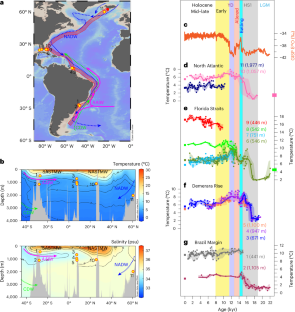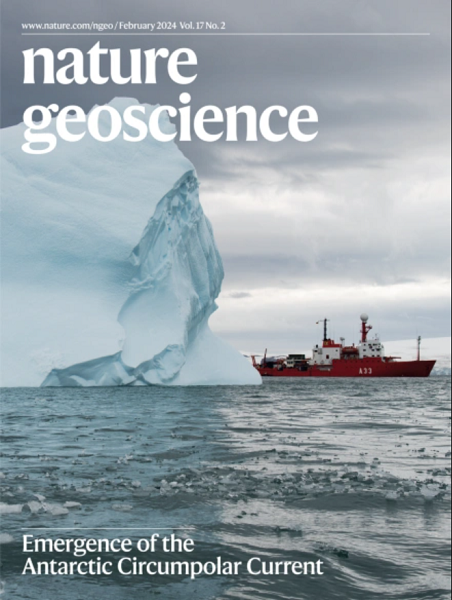Warmer shallow Atlantic during deglaciation and early Holocene due to weaker overturning circulation
IF 16.1
1区 地球科学
Q1 GEOSCIENCES, MULTIDISCIPLINARY
引用次数: 0
Abstract
Model simulations project that the Atlantic Meridional Overturning Circulation (AMOC) will weaken in response to global warming, but with large uncertainty. The past 20 kyr are a prime target for model validation, as boundary conditions are reasonably well known, and the AMOC and climate experienced dramatic changes during this period. Here we present eight subsurface Atlantic temperature reconstructions based on benthic foraminiferal magnesium-to-lithium ratios, and compare the timing and amplitude of reconstructed changes with those in two coupled climate model simulations. We show that compared with the last glaciation and the past 8 kyr, the shallow (~500–1,100 m water depth) tropical North Atlantic was anomalously warm during most of the last deglaciation and early Holocene, which the models suggest is due to a relatively weak AMOC that reduced advection and allowed heat to accumulate. Our temperature reconstructions imply that the AMOC strengthened ~14.7 kyr ago and during the early Holocene (from ~12 to 8 kyr ago), suggesting that enhanced northward heat transport contributed to Northern Hemisphere warming and deglacial melting at these times. The transient model simulations predict features of temperature reconstruction with varying success, possibly because deglacial and Holocene AMOC strength are poorly constrained, and not accurately simulated. A build-up of warm water in the shallow tropical Atlantic during the last deglaciation and early Holocene probably resulted from intervals of weaker Atlantic Meridional Overturning Circulation, according to proxy records and model simulations.


在去冰期和全新世早期,由于较弱的翻转环流,大西洋浅层变暖
模式模拟预测大西洋经向翻转环流(AMOC)将因全球变暖而减弱,但存在很大的不确定性。过去20 kyr是模式验证的主要目标,因为边界条件相当已知,并且AMOC和气候在此期间经历了剧烈变化。在此,我们基于底栖有孔虫镁锂比重建了8个大西洋地下温度,并将重建的变化时间和幅度与两个耦合气候模式模拟结果进行了比较。结果表明,与末次冰期和过去8kyr相比,末次冰期和全新世早期的大部分时间里,北大西洋热带浅层(~500 - 1100 m水深)异常温暖,模式认为这是由于相对较弱的AMOC减少了平流,使热量积累。温度重建表明,在~14.7 kyr前和全新世早期(~12 ~ 8 kyr前),AMOC增强,表明在这两个时期,向北热输送的增强促进了北半球变暖和去冰融化。瞬态模式模拟对温度重建特征的预测成功率不同,可能是因为去冰期和全新世AMOC强度约束较差,无法准确模拟。
本文章由计算机程序翻译,如有差异,请以英文原文为准。
求助全文
约1分钟内获得全文
求助全文
来源期刊

Nature Geoscience
地学-地球科学综合
CiteScore
26.70
自引率
1.60%
发文量
187
审稿时长
3.3 months
期刊介绍:
Nature Geoscience is a monthly interdisciplinary journal that gathers top-tier research spanning Earth Sciences and related fields.
The journal covers all geoscience disciplines, including fieldwork, modeling, and theoretical studies.
Topics include atmospheric science, biogeochemistry, climate science, geobiology, geochemistry, geoinformatics, remote sensing, geology, geomagnetism, paleomagnetism, geomorphology, geophysics, glaciology, hydrology, limnology, mineralogy, oceanography, paleontology, paleoclimatology, paleoceanography, petrology, planetary science, seismology, space physics, tectonics, and volcanology.
Nature Geoscience upholds its commitment to publishing significant, high-quality Earth Sciences research through fair, rapid, and rigorous peer review, overseen by a team of full-time professional editors.
 求助内容:
求助内容: 应助结果提醒方式:
应助结果提醒方式:


